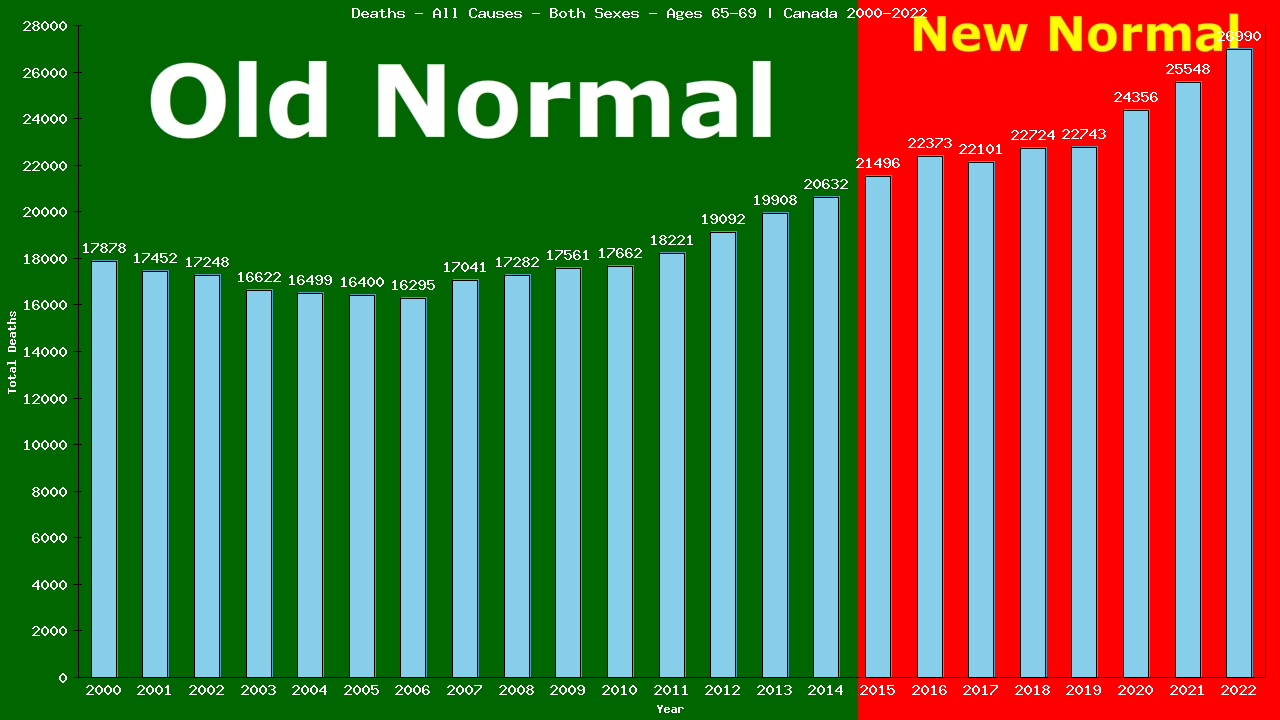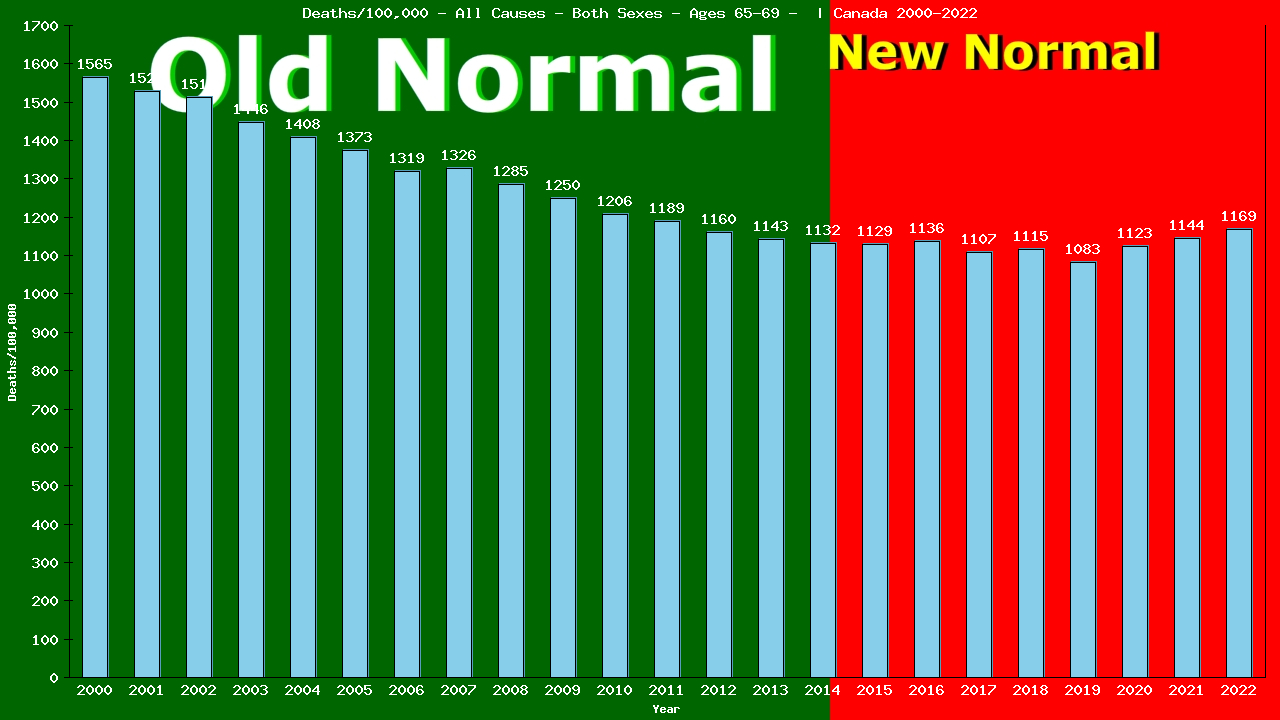
Lives Saved
Lives Saved
in
2022
- Deaths: Government of Canada
- Population: Government of Canada
Quick Links
- There were a total of 334,081 deaths in Canada in 2022
- 26,990 of all deaths were among those aged 65-69
26,990 deaths from All Causes were among elderly men and women aged 65-69
2022 vs New Normal™ for elderly men and women aged 65-69 in Canada
- 26,990 of 26,990 total deaths were from All Causes
- 100.00% of all deaths were from All Causes
- This is down 10% compared to Old Normal rates.
- 30,053 of 30,053 total deaths would have been expected under Old Normal conditions.
- 3,063 fewer than expected deaths from All Causes in 2022.
- 29,256 fewer than expected deaths from All Causes (2015-2022)
- To show this year’s deaths from All Causes are down 10% compared to Old Normal rates, we need to calculate the rates for both 2022 and for the Old Normal.
Remember, death rates are calculated to answer these questions:
- “How many elderly men and women aged 65-69 were there?” and
- “How many of them died from All Causes?”
The following 2 charts provide this information:
Deaths – All Causes – Both Sexes – Aged 65-69 | Canada, Canada

Population – Both Sexes – Aged 65-69 – [2000-2022] | Canada, Canada
![Graph showing Population - Both Sexes - Aged 65-69 - [2000-2022] | Canada, Canada](/wp-content/plugins/dfuc-display/charts/canada/canada/2022/all/Both Sexes/65-69-pop.png)
From the charts, we can see that in 2022, 26,990 of 2,308,096 elderly men and women aged 65-69 living in Canada died from All Causes.
26,990 ÷ 2,308,096 = 0.01169 (2022 CDR)
Deaths/100,000 Both Sexes 65-69 from All Causes

The table shows there were a total of 265,793 deaths from All Causes among 20,413,091 elderly men and women aged 65-69 living in Canada in the 15 years immediately prior to the New Normal™.
265,793 ÷ 20,413,091 = 0.01302 (Old Normal CDR)
We can use the Old Normal rate to predict this year’s deaths:
2022 pop X Old Normal CDR = expected deaths
2,308,096 X 0.01302 = 30,053 expected deaths
The difference between actual and expected deaths shows lives saved or lost:
26,990 – 30,053 = -3,063
Dividing the actual deaths by the expected deaths gives us the comparative rates:
26,990 ÷ 30,053 = 0.8974
This reveals 3,063 lives saved and is 89.74% of what we expected (a decrease of 10%) in deaths from All Causes among elderly men and women aged 65-69 living in Canada in 2022, as compared to the Old Normal.
This is the same method used by Public Health to calculate the 5-yr CDR (Cumulative Death Rate):
161,341 ÷ 14,402,714 = 0.01120 (5-yr CDR)
2,308,096(2022 pop) X 0.01120 = 25,856 expected deaths
The difference between actual and expected deaths:
26,990 – 25,856 = 1,134 or 1,134 lives lost
Divide actual deaths by expected deaths:
26,990 ÷ 25,856 = 1.0429 or an increase of 4%
for deaths from All Causes among elderly men and women aged 65-69 living in Canada in 2022, as compared to the previous 5 years.
Compare our Old Normal to the 5yr CDR. Does it tell the same story your TV does?
Finally, the same method can also be used to compare our Old Normal rate to the New Normal™ rate:
New Normal™ population X Old Normal rate = expected deaths
16,710,810 X 0.01302 = 217,587 expected deaths
The difference between actual and expected deaths:
188331 – 217,587 = -29,256 or 29,256 lives saved
Dividing the actual deaths by the expected deaths:
188,331 ÷ 217,587 = 0.8649 or a decrease of 14%
in deaths from All Causes among elderly men and women aged 65-69 living in Canada in the New Normal™, as compared to the Old Normal.
Stephane Bancel and his globalist buddies came up with UN “Sustainable” Development Goal SDG3 – “Ensure healthy lives and promote well-being for all at all ages” and began implementing it in 2015.
Browse through the tabs for all ages below to see the results of 8 years of their New Normal™
Is this health and well being?
Is this “sustainable”?
Can we allow this to continue?
The world has been led to believe that a deadly pandemic swept the globe beginning in 2020, causing an increase in death rates, especially among the elderly
The data show that death rates began to increase in 2015, immediately upon implementation of the UN’s 2030 Agenda for Sustainable Development, that young adults have experienced ever-increasing death rates since, and that death rates among the elderly have remained relatively stable.
Return to the top of the page to select another age category.
×








